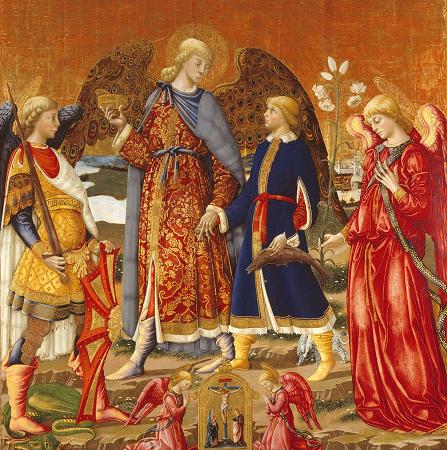Tobit. The Book of Tobit, an Old Testament apocryphal text, has inspired various themes in Western art. Common depictions include Tobit's blindness, the Archangel Raphael guiding Tobit's son Tobias, Tobias catching a fish for its healing properties, Sarah plagued by the demon Asmodeus, the wedding of Tobias and Sarah, and the healing of Tobit's blindness. These scenes showcase drama, redemption, and family values, making the Book of Tobit a popular source for artists like Titian, Veronese, Rembrandt, and Tiepolo. One of the most frequently depicted scenes is Tobit's blindness, which occurs after he is struck by bird droppings that fall into his eyes while he is burying a dead body. This event is often shown as a moment of despair, with Tobit accompanied by his faithful dog. The Archangel Raphael plays a significant role in the story, guiding and protecting Tobit's son, Tobias, on his journey. Raphael is often portrayed as a handsome, youthful figure, sometimes with wings, and is usually shown accompanying Tobias. Another popular scene in Western art is Tobias catching a large fish, as instructed by Raphael. The fish's gall, heart, and liver are used to cure Tobit's blindness and to ward off evil spirits. This scene is often depicted as a moment of triumph, with Tobias holding the fish and Raphael providing guidance. Tobias' future wife, is plagued by the demon Asmodeus, who kills her seven husbands on their wedding nights. Artists often depict Sarah in prayer, seeking divine intervention, or show the moment when Asmodeus is banished by Raphael. The wedding of Tobias and Sarah: The union of Tobias and Sarah is a joyous occasion in the story, representing the triumph of good over evil and the restoration of family. This scene is often depicted as a celebration, with the couple surrounded by family and friends. The healing of Tobit: The climax of the story occurs when Tobias uses the fish's gall to cure his father's blindness. This scene is often shown as a moment of emotional reunion and healing, with Tobit's sight restored and his family reunited. The Book of Tobit is a book of scripture that is part of the Catholic and Orthodox biblical canons. It was recognized as canonical by the Council of Hippo, the Councils of Carthage of 397 and 417, and the Council of Florence, and confirmed in the Counter-Reformation by the Council of Trent. It is not found in Protestant or Jewish biblical canons. The Book of Tobit is listed as a canonical book by the Council of Rome, the Council of Hippo, the Council of Carthage and, the Council of Florence and finally the Council of Trent, and is part of the canon of both the Catholic Church and Eastern Orthodox Churches. Catholics refer to it as deuterocanonical. Augustine and Pope Innocent I affirmed Tobit as part of the Old Testament Canon. Athanasius mentioned that certain other books, including the book of Tobit, while not being part of the Canon, were appointed by the Fathers to be read. According to Rufinus of Aquileia the book of Tobit and other deuterocanonical books were not called Canonical but Ecclesiastical books. Article VI of the Thirty-Nine Articles of the Church of England lists it as a book of the Apocrypha. Protestants regard Tobit as apocryphal because it was not included in the Tanakh nor considered canonical by Judaism. Before the 1952 discovery of Aramaic and Hebrew fragments of Tobit among the Dead Sea Scrolls in a cave at Qumran, scholars believed Tobit was not included in the Jewish canon because of late authorship, estimated to 100 AD. Qumran fragments of the text, which were copied between 100 BC to 25 AD, evidence a much earlier origin than previously thought. These fragments evidence authorship no later than the 2nd century BC and, likely, contemporary with the date ascribed, by modern scholars, to the final compilation of the Book of Daniel, which did attain canonical status. Other scholars have postulated that Tobit was excluded from the Jewish Scriptures for a halakhic reason because Raguel, the bride's father, wrote the marriage document discussed in, instead of the bridegroom, as required by Jewish rabbinical law. However, some ancient Jewish rabbinic scholars possibly considered Tobit to be canonical.
more...














